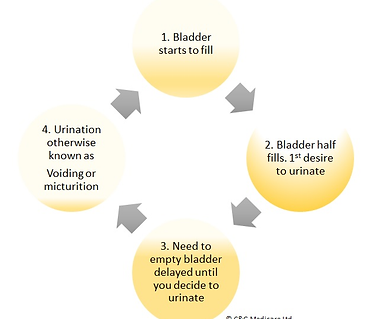About Urinary Incontinence
-
Stress Incontinence
-
Over Active Bladder
-
Overflow
-
Mixed Incontinence
-
Transient
-
Functional
-
Nocturia

About Incontinence
There are many types of incontinences and sometimes one can have more than one type at the same time. Read more....
Overflow
Is where the bladder doesn't empty properly leading to dribbling.
Transient
Transient incontinence is the most difficult to diagnose and complex to treat.

Stress Incontinence
Affects 1 in 3 women. Is the inability to hold urine when laughing, sneezing, jumping....
Over Active Bladder
Over Active Bladder (OAB) is also referred to as urge incontinence
Nocturia
Nocturia is the disturbance of sleep getting up more than 4 times a night to urinate
Urinary incontinence is an inability to hold your urine until you get to a toilet. More than 4 million women in the UK, and over 13 million women in the USA that's around 20% of women in each country young and old experience some sort of incontinence. It is often temporary, and it sometimes could result from an underlying medical condition.
Women experience incontinence twice as often as men. Pregnancy, childbirth, menopause, and the structure of the female urinary tract account for this difference. Both women and men can become incontinent from neurological injury, birth defects, strokes, multiple sclerosis, and physical problems associated with aging.
Older women, more often than younger women, experience incontinence. But incontinence is not inevitable with age. Incontinence is treatable and often curable at all ages. If you experience incontinence, you may feel embarrassed. It may help you to remember that loss of bladder control can be treated.
Try to overcome your embarrassment and see a doctor to learn if you need treatment for an underlying medical condition.
Incontinence is a medical condition just as much as any other condition, which needs to be addressed.
Incontinence in women usually occurs because of problems with muscles that help to hold or release urine. The body stores urine—water and wastes removed by the kidneys—in the bladder, a balloon-like organ. The bladder connects to the urethra, the tube through which urine leaves the body.
During urination, muscles in the wall of the bladder contract, forcing urine out of the bladder and into the urethra. At the same time, sphincter muscles surrounding the urethra relax, letting urine pass out of the body (see Diagram . Incontinence can occur if the bladder (detrusor muscle) suddenly contracts or muscles surrounding the urethra suddenly relax.






